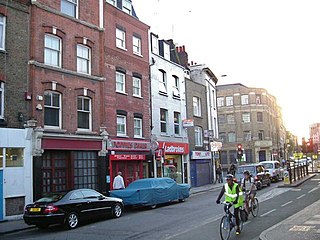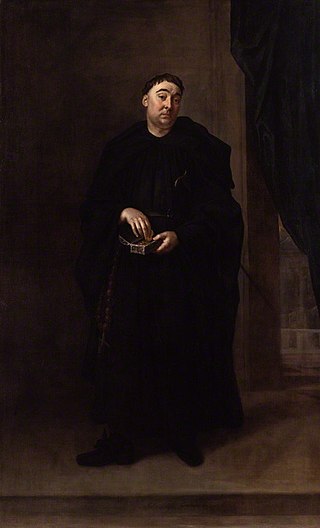Alimony, also called aliment (Scotland), maintenance, spousal support and spouse maintenance (Australia), is a legal obligation on a person to provide financial support to their spouse before or after marital separation or divorce. The obligation arises from the divorce law or family law of each country. In most jurisdictions, it is distinct from child support, where, after divorce, one parent is required to contribute to the support of their children by paying money to the child's other parent or guardian.

Shadwell is an area in London, England and is located in the London Borough of Tower Hamlets. It is in East London and part of the East End. Shadwell is on the north bank of the River Thames between Wapping and Ratcliff and Limehouse and is 3 miles (4.8 km) east of Charing Cross. This riverside location has meant the area's history and character have been shaped by the maritime trades.

Cable Street is a road in the East End of London, England, with several historic landmarks nearby. It was made famous by the Battle of Cable Street in 1936.

Abbey House Gardens is a country house garden in Malmesbury, Wiltshire, England, covering 5 acres (2.0 ha). The garden was transformed in the 1990s by the so-called Naked Gardeners: Ian and Barbara Pollard. In 2021 the property was acquired by new American owners, Whit and Kim Hanks. They plan to convert the house into a boutique hotel, while ensuring that the gardens are regularly opened to the public. During the 2022 summer season the gardens were opened from May to October on the second Saturday of each month.

Sir James Long, 2nd Baronet was an English politician and Royalist soldier.
James Edward Harris, 2nd Earl of Malmesbury was a British peer, styled Viscount FitzHarris from 1800 to 1820.
Major William Rainsborowe, or Rainborowe, was an officer in the English Navy and New Model Army in England during the English Civil War and the Interregnum. He was a political and religious radical who prospered during the years of the Parliamentary ascendancy and was an early settler of New England in North America.

Sir Arthur Gorges was an English sea captain, poet, translator and courtier from Somerset.
Samuel Crawley was an English Whig politician who sat in the House of Commons variously between 1818 and 1841.
Jane Dudley, Duchess of Northumberland was an English courtier. She was the wife of John Dudley, 1st Duke of Northumberland, and mother of Guildford Dudley and Robert Dudley, 1st Earl of Leicester. Having grown up with her future husband, who was her father's ward, she married at about age 16. They had 13 children.

Anthony Leigh was a celebrated English comic actor.
Nathaniel Bladen was an English barrister who was Steward to the Earl of Danby for twenty years as Danby rose to be the most powerful politician of the day before he was engulfed in the Popish Plot and incarcerated in the Tower of London.
William Bladen (1672–1718) was an English-born Attorney-General in Maryland, in what is now the United States, and briefly Secretary of that Province. He was the father of Thomas Bladen, Governor of Maryland and was the brother of Colonel Martin Bladen, Commissioner of the Board of Trade and Plantations. His nephew was Admiral Edward Hawke, 1st Baron Hawke.

Lieutenant General Thomas Farrington was a British Army officer and politician who sat in the English and British House of Commons from 1705 to 1712. He raised the 29th (Worcestershire) Regiment of Foot.

Theodosia Garrow was an English contralto singer who performed with her sisters, Harriett, Eliza and Jane Abrams. She was considered, with Margaret Kennedy, the leading female contralto of her time, and abandoned a promising career upon her marriage.
Thomas Thorowgood, B.D., was a Puritan minister and preacher in King's Lynn, Norfolk, England. He was the first English author to argue in 1650 that American Indians were descended from the Lost Ten Tribes of the biblical ancient Israelites. This theory was an early 16th century Christian theory that was revived in popularity during the beginning of the English colonisation of North America in the 17th century.
Theodosia Harington, Lady Dudley was an English aristocrat who was abandoned by her husband, but maintained connections at court through her extensive family networks.

Sarah Harington (1565–1629) was an English courtier.

Theodosia, Lady Ivie or Ivy (1628–1697) was an aristocratic heiress and a figure of notoriety in the east end of London in the 17th century. Famed for her “wit, beauty and cunning in law above all others,” her claims to own land stretching from Wapping to Ratcliff led to a constant stream of litigation which ran for almost 75 years. At one particular trial, presided over by Lord Chief Justice Jeffreys, evidence emerged that Ivie had presented the court with forged deeds on which she made her land claims and Jeffreys subsequently arranged for charges to be brought against her for forgery.
Isaac Sardo Abendana was a Dutch Jewish jeweller and diamond merchant of Madras, India. Originally from Holland, Abendana moved to India in 1702. Due to his skill in the trade, Abendana was widely consulted, including by most Madras trading companies and by his close friend, Thomas Pitt, the governor of Fort St. George.









